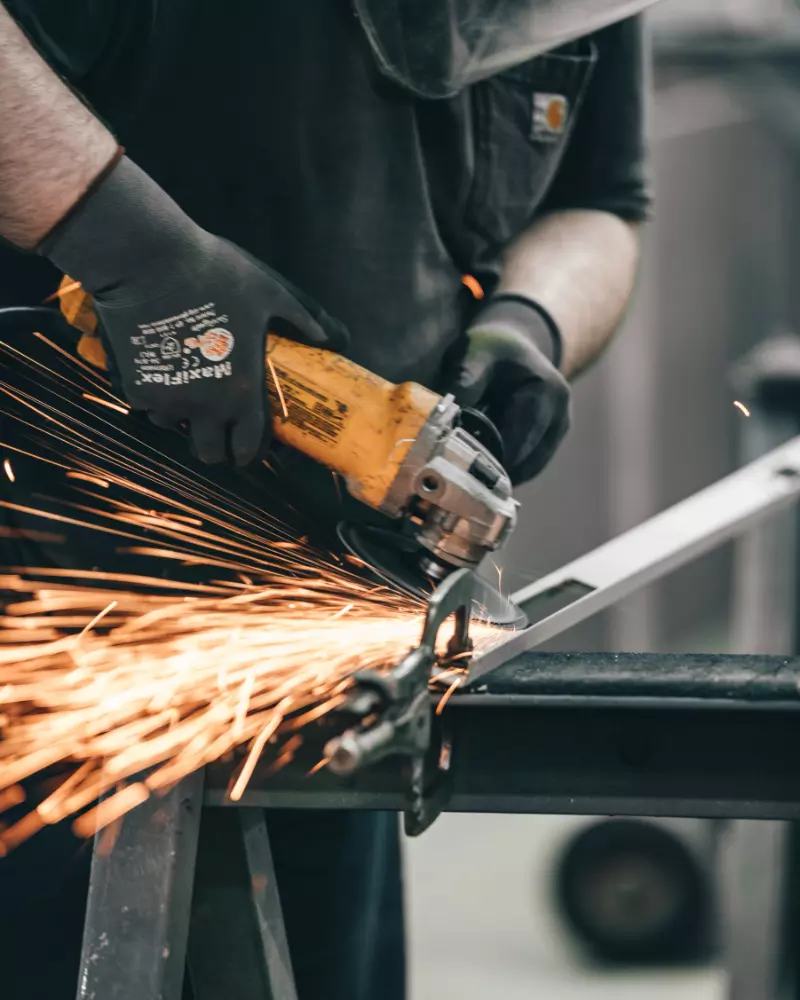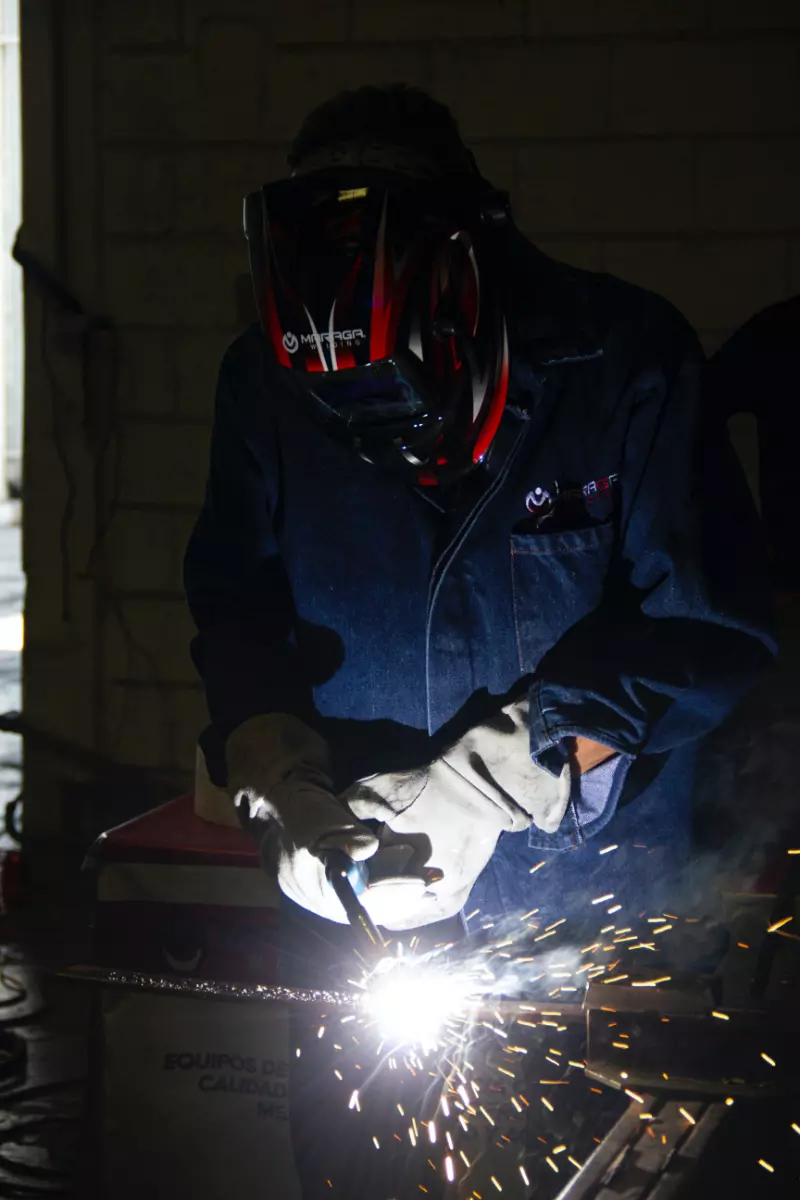This article looks at: what are plasma cutters used for? Find out more about plasma cutters and the common uses of plasma cutting.
What is Plasma Cutting?
Plasma cutting is categorised as a profile cutting technique that can slice through every kind of conductive metal, including brass, copper, titanium, steel and aluminium.
Moreover, a plasma cutting tool can be used on both thick and thin metal materials. Plasma cutting can be completed by hand, or for more industrial projects, a CNC plasma cutting machine can be used. The CNC machines are computer-run systems to deliver a precise and clean cut at any angle.
A handheld plasma torch can be used when choosing to weld by hand. These may be referred to as a plasma gun, plasma cutter or plasma arc. The plasma torch you choose for a project will depend on the thickness of the metal being cut.
Furthermore, the application of the plasma cut will impact your choice; in more industrial environments, a CNC Plasma Cutting Machine may be preferred as it cuts profiles from a digital file onto a larger sheet of metal. As it's a mechanical process, the cut is incredibly precise.
Plasma cutting is quite cost-effective compared to other metalwork processes like laser cutting or water-jet cutting. It also has immediate, clean and concise results when completed by hand or machine.
How does Plasma Cutting work?
Plasma is the fourth state of matter, along with liquid, solid, gas and Bose-Einstein condensate. Plasma is formed when an electric arc passes through a gas, usually oxygen, nitrogen, argon or shop air. Plasma can then squeeze through a small opening (nozzle) at super-fast speeds and incredibly hot temperatures, allowing it to slice conductive metals with ease.
Plasma is an electrical conductor, so it can form a circuit with the workpiece (metal or other material) that is being cut, in turn giving the plasma arc the ability to cut through materials like a knife in butter. The process of heat and gas enables the transition from solid to plasma effortlessly.
Using a plasma cutter is significantly safer than a saw when cutting through metals, so it is the favoured method for most metal workers. Many high-quality plasma cutters also have a 'pilot arc' located between the electrode and nozzle; it ionises the gas before arc transfer companies. Whilst lesser cutters begin plasma creation at the torch tip when it's sparked against the metal surface being cut or by using a starting circuit (like a car engine spark plug).
NOTE: To run a CNC plasma cutting machine, you must have a pilot arc available.
What is the purpose of a Plasma Cutter?
A Plasma cutter is an incredibly useful tool that takes little effort to use whilst producing high-quality and clean results.
Metal is one of the strongest construction materials on the market, and metalworkers know how incredibly resilient it can be to manipulate without powered machinery.
Thanks to the fabrication of plasma cutting tools, the problems associated with working with metals are drastically reduced.
Without the creation of plasma cutting machines, we would lose the ability to effortlessly slice through metals, whether brass to stainless steel.
Steel and other metals are often used for large construction projects, and without plasma cutting, all metalwork would take a LOT longer!

What materials can a Plasma Cutter cut?
To create a flame, plasma cutters require a high-velocity ionised gas (oxygen, nitrogen, argon etc.) to ignite the flame used to cut through any conductive metal. Below we list the metals plasma cutting works with;
Mild steel
Stainless steel
Carbon steel
Expanded steel
Other ferrous (iron-containing) and non-ferrous materials
Aluminium
Copper
Brass
Depending on the type of plasma cutter, you can cut a range of metals, the stronger the cutter, the thicker it can cut. More heavy-duty plasma cutters can slice metal material ranging from 1mm to 1inch. Thicker metal would require a more powerful cutter or even an automated CNC plasma cutting machine.
The main takeaway is that plasma cutters will only work if the metal being cut is electrically conductive, as this conductivity is what reacts with the ionised gas. Even poorly conductive metals, like tin, cannot be cut with a plasma cutter. Some examples of materials plasma cutters don't work on are;
Wood
Glass
Plastic
Manganese
Lead
Tungsten
Tin
What are the advantages of Plasma Cutting?
A major advantage of plasma cutting is that it's easily portable, as the cutter can be miniaturised until it's a small handheld device, perfect for transportation across worksites. Another key benefit is that skills of plasma cutting can be learnt relatively easily, so new workers won't have extended training periods.
Other advantages;
- Plasma torches can be precisely guided along a line as easy as a pencil on paper. It can cut curves, strange shapes or multiple intersecting cuts, using either manual or computer-aided controls.
- Using a plasma cutter is the quickest and most effective way to cut through metal; in fact, it only takes a fourth of the time that most other similar techniques take! A quick and efficient cut also reduces risks of error cuts, distortion and metal abrasion.
- A wide range of materials can be cut using a plasma cutter! Including; Steel, Iron, Copper, Titanium and alloys.
- Plasma cutters are very cost-effective, as well as energy-efficient. Moreover, the cutters are low-maintenance and rarely need replacing. The plasma cutter offers a 1:2 ratio per cut compared to oxygen cutting.
- Using inert gases, as plasma cutters do, is much safer than oxygen-based cutting techniques. There is a significant risk of explosion or accidental ignition with plasma cutters as they use Oxy-fuel. So when the plasma cutter is in storage or use, it should be treated carefully. However, plasma cutting gas only gets converted into superhot plasma whilst the torch is actually in use.
What Are The Disadvantages Of Plasma Cutting?
Although there are numerous advantages to using Plasma Cutting, there are also a few downsides. Below we discuss the few disadvantages associated with using a plasma cutter during metalworks.
- Thicker and denser metals are difficult to cut with Plasma cutters, as the nature of plasma means its depth reach is limited to around one inch. For thick metal pillars or blocks, you'd be best using traditional industrial melting or sawing techniques.
- Plasma cutting is noisy, and it can generate an excess of fumes, even though the cutter limits ambient heat. For these reasons, all plasma cutting should take place in an open workspace, with fresh air circulated.
- Infamously, plasma creates very bright flashes whilst cutting is going on. Ensure that no employees are close to the plasma cutter without the correct safety equipment and eye protection.
- Although plasma cutting is cheaper than Oxy-fuel alternatives, it can still incur various costs. It can be expensive to source and replace any damaged Electrodes; similarly, specialist gas can be pricey.
How to get a high-quality cut using a Plasma cutter
A plasma arc goes through various processes from its creation at the electrode to the workpiece. Many of the arc processes influence the final cut quality, with the type of shielding gas or liquid chosen to have a major impact. There are a few pointers to recognise a high-quality cut, these include;
Low Bevel Angle (0-1°)
No Bottom Dross
No Top Edge Rounding
The minimal heat-affected zone (HAZ)
A smooth cut surface

Other factors like the stability of the plasma arc column (largely owed to design), and the work table or robot's accuracy, will affect the overall quality of a plasma cut.
Moreover, to achieve optimal cutting quality, the torch should be at the proper height allowing only minimal bevel angle. The optimal plasma cutting speed depends on the plasma cutter machine; too fast or too slow, and the quality of the cut is compromised.
If the torch foes too fast, it can lead to high-speed dross. High-speed Dross then sticks to the base of the cut, and it's relatively difficult to grind away. Whilst if the torch is being moved too slow, low-speed dross is produced. Low-speed Dross is thicker, permeable and easier to remove than high-speed dross.
Yet, it increases the heat put into the workpiece material, in turn creating a larger Heat affected zone (HAZ) and top edge rounding. HAZ, or heat-affected zone, refers to the area of metal that wasn't melt melted.
Yet, it has undergone property changes owing to the exposure to high temperatures whilst welding occurs. Rough or contaminated cut edges can cause issues for the welder.
To avoid these problems, the welder can change travel speeds, use different filler metals and consider grinding prior to welding. Grinding the material produces a surface for short-circuit gas metal arc welding, yet without grinding, it can lead to weld pools freezing over quickly trapping in contaminants (nitrogen etc.).
Flux-core welding, or submerged arc welding, produces slower-freezing weld pools meaning more contaminants are outgassed, producing a higher finish.
Can you weld using a plasma cutter?
Short answer, No. Although the plasma cutter works similarly to TIG welding as both use the arc technique, the plasma cutter doesn't have the capabilities to join together metals. Both TIG welding and plasma cutting have a tungsten electrode within a copper nozzle that has a small opening.
The electric arc produced by the electrode is what melts the metals to allow for the fusion of two or more metals during TIG welding, whilst the arc in plasma cutting is used to slice through a singular piece of metal.
A 'multi-process machine' offers the benefits of three separate welding industry components; a TIG welder, a plasma cutter and a stick welder. The benefit of having all tools in one makes the machine a popular choice for hobbyists, small shops and other industries like farmers. The multi-process machine uses the same pieces for TIG welding and plasma cutting, reducing the need for dedicated tools.
Are you looking for welding equipment suppliers in Coventry and Warwickshire. Contact our welding equipment specialists working across Coventry, Rugby, Oxford and the surrounding areas.


